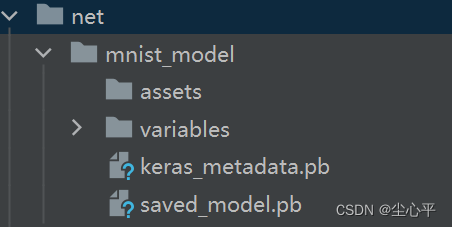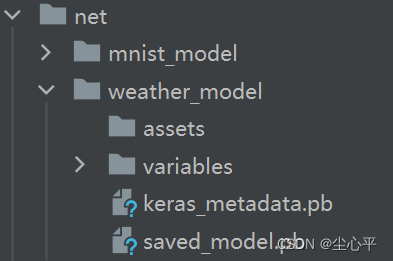活动地址:CSDN21天学习挑战赛

目录
如何保存神经网络模型
在训练时保存模型
在训练时保存模型主要是利用 ModelCheckpoint() 函数的功能
ModelCheckpoint()函数的介绍
ModelCheckpoint()函数的全称是 tf.keras.callbacks.ModelCheckpoint
函数的主要功能是在指定的epoch后,保存模型到指定的路径处
def __init__(self, filepath, monitor='val_loss', verbose=0, save_best_only=False, save_weights_only=False, mode='auto', save_freq='epoch', options=None, initial_value_threshold=None, **kwargs):
- filepath:str类型,保存模型的路径
当设置save_weights_only为False,即保存模型时,传的filepath需要是已存在的目录
当设置save_weights_only为True,即保存模型权重时,传的filepath需要是已存在的文件
- monitor:dtr类型,表示监视值,可以是 val_accuracy、val_loss、accuracy和loss
- verbose: 默认是0,表示输出不显示保存信息,为1表示显示信息,具体信息可见下图的Epoch 1:
- save_best_only:默认为False,表示保存所有调用回调函数时的模型(可以选择加载最新的模型),如果为True,表示仅保存在验证集上表现最好的模型
- save_weights_only:默认为False,表示是否仅保持模型的权重参数,为False是指表示整个模型
mode:str类型,可以是”auto“、"max"、"min" 三者之一,auto时较常用,可以由monitor值自动推断出mode值(accuracy——max,loss——min 包括val也是这样对应)
- 还可以传period参数,默认为1,表示隔1个epoch就进行函数回调
使用时,一般只需要传参 filepath、save_best_only和save_weights_only即可,其余参数视情况补充
保存模型权重参数
这里我们选择之前的MNIST手写数字识别所搭建的网络模型
(train_image, train_label), (test_image, test_label) = tf.keras.datasets.mnist.load_data() train_image = train_image / 255.0 test_image = test_image / 255.0 train_image = train_image.reshape((-1, 28, 28, 1)) test_image = test_image.reshape((-1, 28, 28, 1)) model = models.Sequential([ layers.Conv2D(32, (3, 3), padding="same", activation="relu", input_shape=(28, 28, 1)), layers.MaxPooling2D(), layers.Conv2D(64, (3, 3), activation="relu", padding="same"), layers.MaxPooling2D(), layers.Flatten(), layers.Dense(64, activation="relu"), layers.Dense(10) ]) model.summary() model.compile(optimizer="adam", metrics="accuracy" , loss=tf.keras.losses.SparseCategoricalCrossentropy(from_logits=True)) history = model.fit(train_image, train_label, epochs=10, validation_data=(test_image, test_label)) # 输出网络模型loss、val_loss变化曲线 plt.plot(history.history['accuracy'], label='accuracy') # 训练集准确度 plt.plot(history.history['val_accuracy'], label='val_accuracy ') # 验证集准确度 plt.plot(history.history['loss'], label='loss') # 训练集损失程度 plt.plot(history.history['val_loss'], label='val_loss') # 验证集损失程度 plt.xlabel('Epoch') # 训练轮数 plt.ylabel('value') # 值 plt.ylim([0, 1.5]) plt.legend(loc='lower left') # 图例位置 plt.show() pre = model.predict(test_image) plt.figure(figsize=(10, 20)) for i in range(10): print(np.array(pre[i]).argmax()) for i in range(10): plt.subplot(5, 10, i + 1) plt.xticks([]) plt.yticks([]) plt.grid(False) plt.imshow(test_image[i], cmap=plt.cm.binary) plt.xlabel(test_label[i]) plt.show()保存模型参数主要包括以下几部分操作:
- 设置保存路径
# 设置路径地址 save_path = "net/weights/mnist.ckpt" # 创建新文件 os.open(file_url,os.O_CREAT) save_dir = os.path.dirname(save_path) os.makedirs(save_dir) os.open(save_path, os.O_CREAT) # 也可以使用pathlib库创建
- 编写回调函数
cp_callback = tf.keras.callbacks.ModelCheckpoint( filepath=save_path, save_weights_only=True )
- fit添加回调函数并进行编译运行神经网络
model.fit(train_image, train_label, epochs=10, validation_data=(test_image, test_label), callbacks=[cp_callback])保存的数据文件有:
使用保存好的模型参数(默认是加载最新的):
# 读取保存好的模型参数 save_path = "net/weights/mnist/mnist.ckpt" val_loss, val_accuracy = model.evaluate(test_image, test_label, verbose=1) model.load_weights(save_path) val_loss, val_accuracy = model.evaluate(test_image, test_label, verbose=1) # 利用加载好的模型参数预测 pre = model.predict(test_image) plt.figure(figsize=(10, 20)) for i in range(10): print(np.array(pre[i]).argmax()) for i in range(10): plt.subplot(5, 10, i + 1) plt.xticks([]) plt.yticks([]) plt.grid(False) plt.imshow(test_image[i], cmap=plt.cm.binary) plt.xlabel(test_label[i]) plt.show()这是训练时的最后一次epoch的val_loss、val_accuracy
这是未加载参数时网络模型的 val_loss、val_accuracy
这桑加载完保存好的参数时网络模型的val_loss、val_accuracy
观察得到最后一次epoch时数据与加载后数据相一致
所以默认加载的是最后一次的epoch时的权重参数
保存整个网络
保存整个网络时,需要用到的路径需要是一个目录
回调函数处的 save_weights_only也需要改为False,至于save_best_only取决于用户需要(这里默认保存的是最后一次epoch时的模型,True是保存训练过程中,val_loss最低的模型)
保存模型的相关代码如下:
# 设置路径地址 save_path = "net/mnist_model" # 创建目录 pathlib.Path.mkdir(pathlib.Path(save_path),parents=True) cp_callback = tf.keras.callbacks.ModelCheckpoint( filepath=save_path, save_weights_only=False ) model.fit(train_image, train_label, epochs=10, validation_data=(test_image, test_label), callbacks=[cp_callback])保存整个模型的文件夹内的文件:
加载模型是通过 tf.keras.models.load_model() 加载,具体用法见后面的SavedModel方式介绍
SavedModel方式
使用SavedModel方式较为简单,主要是通过 model.save(路径) 保存模型和 tf.keras.models.load_model(路径) 加载模型,这里的路径也是目录
保存以后的目录内的文件也是下面的图片:
使用方法
model.save(目录路径)
model=tf.keras.models.load_model(目录路径)
示例代码
(train_image, train_label), (test_image, test_label) = tf.keras.datasets.mnist.load_data() train_image = train_image / 255.0 test_image = test_image / 255.0 train_image = train_image.reshape((-1, 28, 28, 1)) test_image = test_image.reshape((-1, 28, 28, 1)) model = models.Sequential([ layers.Conv2D(32, (3, 3), padding="same", activation="relu", input_shape=(28, 28, 1)), layers.MaxPooling2D(), layers.Conv2D(64, (3, 3), activation="relu", padding="same"), layers.MaxPooling2D(), layers.Flatten(), layers.Dense(64, activation="relu"), layers.Dense(10) ]) model.summary() model.compile(optimizer="adam", metrics="accuracy" , loss=tf.keras.losses.SparseCategoricalCrossentropy(from_logits=True)) history = model.fit(train_image, train_label, epochs=10, validation_data=(test_image, test_label)) # 读取保存好的模型参数 save_path = "net/mnist_model" model.save(save_path) val_loss, val_accuracy = model.evaluate(test_image, test_label, verbose=1) model1 = tf.keras.models.load_model(save_path) val_loss, val_accuracy = model1.evaluate(test_image, test_label, verbose=1) pre = model1.predict(test_image) plt.figure(figsize=(10, 20)) for i in range(10): print(np.array(pre[i]).argmax()) for i in range(10): plt.subplot(5, 10, i + 1) plt.xticks([]) plt.yticks([]) plt.grid(False) plt.imshow(test_image[i], cmap=plt.cm.binary) plt.xlabel(test_label[i]) plt.show()
HDF5 格式
HDF5格式的使用与SavedModel的使用类似,主要是保存的路径不再是个目录而是个h5文件
仍是用model.save()、tf.keras.models.load_model() 两个方法
model.save(文件名.h5)
model=tf.keras.model.load_model(文件名.h5)
天气识别
数据集的下载
数据集可以在 百度飞桨 Ai Studio 中搜索到
数据集链接 天气识别数据集 - 飞桨AI Studio 下载解压即可
代码
具体操作已在代码中注释,针对过拟合,采用Dropout=0.4
# 天气识别 # 设置本地数据集地址 data_url = "E:/Download/data_set/weather_photos" # 指定标签名 class_names = ["cloudy", "rain", "shine", "sunrise"] # 指定图像长宽 image_height = 256 image_width = 256 # 导入数据集 train_datas = keras.preprocessing.image.image_dataset_from_directory( directory=data_url, class_names=class_names, image_size=(image_height, image_width), seed=123, validation_split=0.2, subset="training", interpolation="lanczos3" ) test_datas = keras.preprocessing.image.image_dataset_from_directory( directory=data_url, class_names=class_names, image_size=(image_height, image_width), seed=123, validation_split=0.2, subset="validation", interpolation="lanczos3" ) train_datas = train_datas.cache().shuffle(500).prefetch(tf.data.AUTOTUNE) test_datas = test_datas.cache().prefetch(tf.data.AUTOTUNE) # 构建卷积神经网络 model = models.Sequential([ layers.Rescaling(1 / 255.0, input_shape=(image_height, image_width, 3)), layers.Conv2D(32, (3, 3), padding="same", activation="relu", input_shape=(None, None, 3)), layers.MaxPooling2D(), layers.Conv2D(64, (3, 3), activation="relu", padding="same"), layers.MaxPooling2D(), layers.Conv2D(64, (3, 3), activation="relu", padding="same"), layers.MaxPooling2D(), layers.Flatten(), layers.Dropout(0.4), layers.Dense(64, activation="relu"), layers.Dense(4) ]) model.summary() # 编译训练网络模型 model.compile(optimizer="adam", loss=tf.keras.losses.SparseCategoricalCrossentropy(from_logits=True), metrics=['accuracy']) # 在model.fit history = model.fit(train_datas, validation_data=test_datas, epochs=10) # 输出网络模型loss、val_loss变化曲线 plt.plot(history.history['accuracy'], label='accuracy') # 训练集准确度 plt.plot(history.history['val_accuracy'], label='val_accuracy ') # 验证集准确度 plt.plot(history.history['loss'], label='loss') # 训练集损失程度 plt.plot(history.history['val_loss'], label='val_loss') # 验证集损失程度 plt.xlabel('Epoch') # 训练轮数 plt.ylabel('value') # 值 plt.ylim([0, 1.5]) plt.legend(loc='lower left') # 图例位置 plt.show() # 预测 pre = model.predict(test_datas) for i in range(20): print(pre[i]) print(class_names[numpy.array(pre[i]).argmax()]) # 绘画数据集图像,查看导入是否完成 plt.figure(figsize=(20, 10)) for test_image, test_label in test_datas.take(1): for i in range(20): plt.subplot(5, 10, i + 1) plt.xticks([]) plt.yticks([]) plt.grid(False) plt.imshow(test_image[i].numpy().astype('uint8') / 255.0, cmap=plt.cm.binary) plt.xlabel(class_names[test_label[i]]) plt.show() # 用savedmodel方式保存整个网络,也可以用.h5文件,也可以用checkpoint保存整个模型 # 也可以用checkpoint保存权重参数加载模型 save_path = "net/weather_model" model.save(save_path)保存的目录结构
加载所保存的模型,进行预测
save_path = "net/weather_model" model = tf.keras.models.load_model(save_path) pre = model.predict(test_datas) for i in range(32, 42): # batch_size 默认为32 print(pre[i]) for i in range(32, 42): # batch_size 默认为32 print(class_names[numpy.array(pre[i]).argmax()]) for test_image, test_label in test_datas.take(2): for i in range(20): # 第二张图前十个天气是预测的真实值 plt.subplot(5, 10, i + 1) plt.xticks([]) plt.yticks([]) plt.grid(False) plt.imshow(test_image[i].numpy().astype('uint8') / 255.0, cmap=plt.cm.binary) plt.xlabel(class_names[test_label[i]]) plt.show()真实值:
预测值:
[-20.913506 -13.227225 -6.835453 16.999655] [ 3.6401439 3.7265291 0.96968377 -10.230032 ] [ 2.0867512 4.413174 0.4877592 -10.106009 ] [-5.611314 -6.928367 1.4171107 2.662863 ] [ 4.0711594 -4.901644 3.7610795 -6.6193724] [ 1.510512 6.4153357 -0.17131034 -9.647087 ] [ 5.199197 -1.9983941 -2.0065382 -3.3040116] [ 0.04972115 -3.3614075 4.4348345 -8.757731 ] [ 0.49389228 5.2676754 -0.5260849 -8.89126 ] [-1.826133 -5.6637144 3.5098753 -6.234786 ] sunrise rain rain sunrise cloudy rain cloudy shine rain shine






























 2万+
2万+

 被折叠的 条评论
为什么被折叠?
被折叠的 条评论
为什么被折叠?








